How Long Does Dehydrated Food Last if Vacuum Sealed
When properly vacuum sealed, your dehydrated foods can last considerably longer than traditional storage methods. Vegetables typically last 10-15 years, while fruits range from 4-8 years depending on their sugar content. Meats and proteins can maintain quality for 5-10 years, and grains can last up to 25-30 years. You'll need to store items in cool, dark conditions (50-70°F) with humidity below 60% and make sure foods are completely dried before sealing, with moisture content under 10% for vegetables and 5% for meats. Several factors can affect these timeframes, including storage conditions, preparation methods, and packaging quality.
This post may contain affiliate links. If you make a purchase through these links, I may earn a commission at no additional cost to you. Additionally, portions of this post may be generated using artificial intelligence (AI) technology. While we strive for accuracy, please be aware that AI-generated content may not always be perfect and should be fact-checked when necessary.
The Spatula Scoops
- Properly vacuum-sealed dehydrated vegetables can last 10-15 years when stored in cool, dark conditions with humidity below 60%.
- Dehydrated fruits have varying shelf lives: apples and bananas last 5-8 years, while berries and citrus fruits last 4-6 years.
- Dried meats and proteins can maintain quality for 5-10 years when vacuum sealed, depending on fat content and processing methods.
- Grains and dried legumes have the longest shelf life, lasting 25-30 years when vacuum sealed and stored at 40-70°F.
- Herbs and spices generally last 2-5 years when vacuum sealed, with leafy herbs having shorter storage duration.
Understanding Vacuum Sealing Basics

Vacuum sealing stands as a cornerstone technique in food preservation, removing air from storage containers to prevent bacterial growth and oxidation. When you're working with dehydrated foods, you'll need to understand that vacuum sealing creates an airtight environment that considerably extends shelf life by eliminating oxygen, which is responsible for food degradation.
You'll find two main types of vacuum sealing methods: external and chamber vacuum sealers. External sealers, which you'll commonly use at home, work by drawing air out through specially designed bags with textured channels. Chamber sealers, typically used in commercial settings, remove air from an entire chamber containing the food package.
To achieve ideal results, you'll want to verify your dehydrated foods are completely cool and thoroughly dried before sealing. The moisture content should be below 10% to prevent spoilage. When you're selecting vacuum seal bags, choose those specifically designed for long-term storage, with multiple layers and proper thickness ratings. Remember that the quality of your seal directly impacts storage life, so you'll need to check that the seal is complete and unbroken before storing.
Optimal Storage Conditions
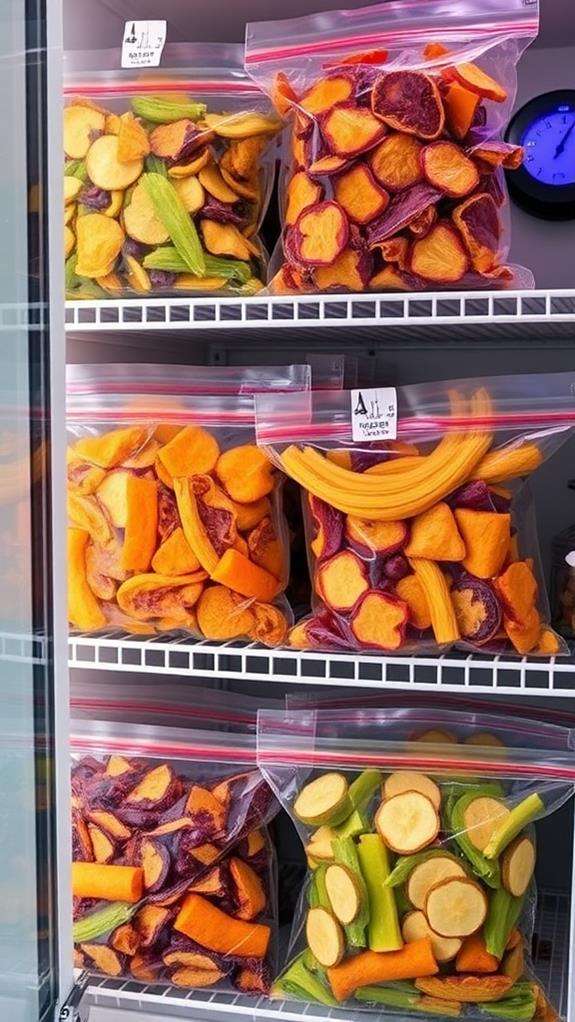
Maintaining proper storage conditions proves vital for maximizing the shelf life of your dehydrated foods. You'll want to store your vacuum-sealed items in a cool, dark place where temperatures remain between 50-70°F (10-21°C), as heat and light can degrade both food quality and packaging integrity over time.
Your storage area should maintain a relative humidity level below 60%, and you'll need to keep your dehydrated foods away from areas prone to temperature fluctuations, such as near stoves, heating vents, or exterior walls. Consider using food-grade storage containers or mylar bags as additional protection for your vacuum-sealed packages, especially if you're planning for long-term storage.
Monitor your storage space regularly for signs of pest infestation or moisture accumulation, and you shouldn't stack heavy items on top of your vacuum-sealed packages, as this can compromise the seals. It's also essential to label each package with the contents and date of preservation, allowing you to rotate your stock effectively. When you're organizing your storage area, remember to place newer items behind older ones to guarantee you're using the oldest products first.
Common Food Storage Mistakes
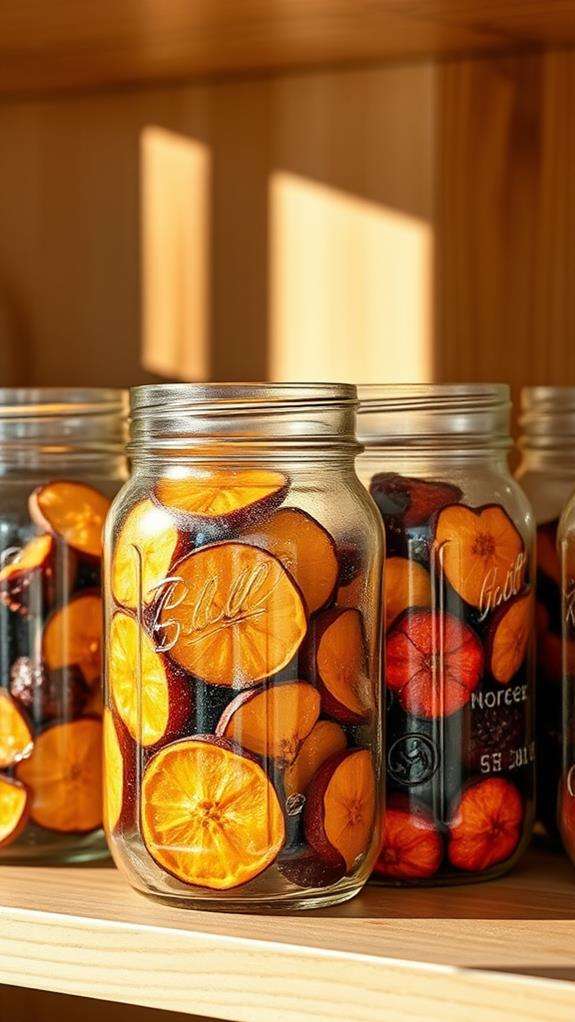
Despite careful preparation, many people fall into common traps when storing their dehydrated foods. You'll want to avoid these mistakes to protect your investment and guarantee your food remains safe to eat.
One of the biggest errors you're likely to make is not checking your storage containers regularly for damage or seal failures. Even a tiny crack can let moisture seep in, leading to spoilage. You'll also need to watch out for storing dehydrated foods in areas with temperature fluctuations, as this can cause condensation inside your containers.
Another mistake you're probably making is not labeling your containers with contents and dates. You can't rely on memory alone, and proper rotation becomes impossible without clear dating. You're also putting your food at risk if you're reusing containers without thoroughly cleaning and drying them first.
Don't fall into the trap of mixing different moisture content foods in the same container. Your perfectly dried apples can rehydrate from moisture released by incompletely dried pieces. Finally, you'll want to avoid storing your dehydrated foods in direct sunlight or near heat sources, as this can degrade both the food and the storage containers.
Dehydration Process Requirements
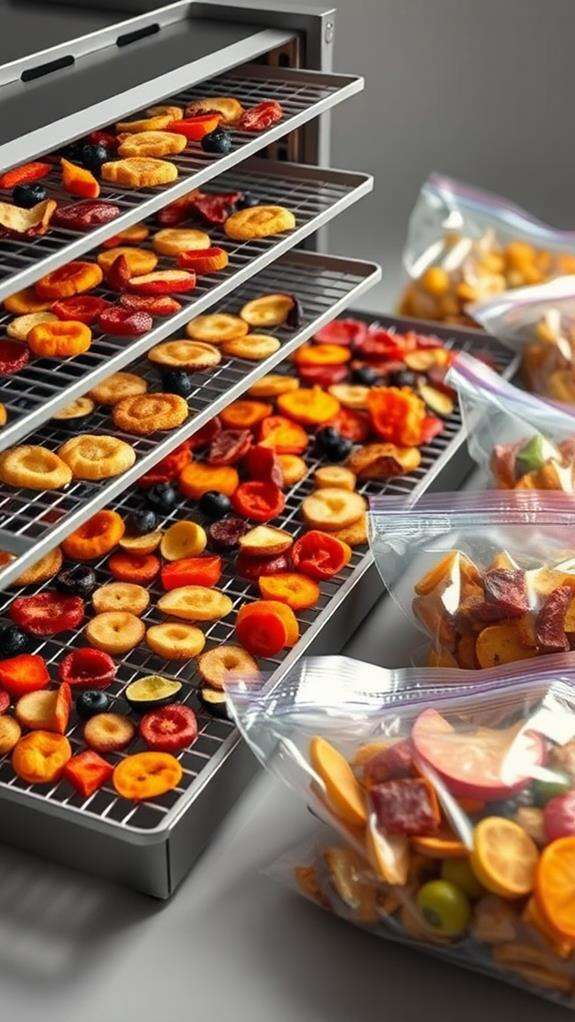
Proper dehydration requires careful attention to several key factors that directly impact food preservation success. You'll need to maintain consistent temperatures between 125-135°F for most foods, guaranteeing your dehydrator provides even heat distribution throughout all trays. The process typically takes 6-16 hours, depending on your food's water content and thickness.
Your food preparation must be meticulous, starting with selecting fresh, high-quality ingredients. You'll want to cut items uniformly, typically 1/4 inch thick, to guarantee even drying. Before beginning, you should pretreat fruits with lemon juice or ascorbic acid to prevent browning, while blanching vegetables helps retain color and nutrients.
Humidity control is vital during the dehydration process. You'll need to maintain proper airflow and keep ambient humidity below 60%. It's imperative to rotate trays every few hours and check food regularly for proper dryness. You can test readiness by cutting pieces in half – they should be dry throughout with no moisture pockets. Most fruits should feel leathery but pliable, while vegetables should be brittle. Always let foods cool completely before storage to prevent condensation.
Best Foods for Long Storage
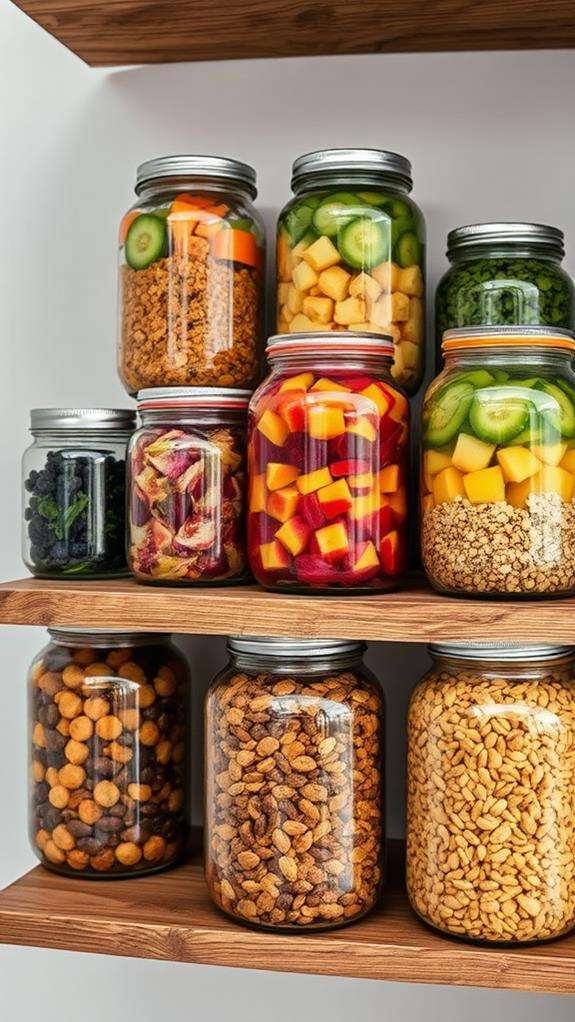
When you're planning to store dehydrated food for the long term, certain foods naturally work better than others, with fruits, root vegetables, grains, and dried legumes leading the pack as top performers. Your storage options expand considerably with herbs and spices, which not only maintain their potency when properly dehydrated but also take up minimal space in your pantry. These food categories, particularly when processed and stored correctly, can maintain their nutritional value and usefulness for months or even years, making them ideal choices for your long-term food storage strategy.
Fruits and Root Vegetables
Among all dehydrated foods, fruits and root vegetables stand out as the longest-lasting options for your storage needs. When properly dehydrated and stored, these items can maintain their nutritional value and taste for extended periods, making them excellent choices for your long-term food preservation strategy.
You'll find that certain fruits and root vegetables perform exceptionally well in dehydrated form:
- Root vegetables like carrots, sweet potatoes, and parsnips can last 10-15 years when properly dehydrated and stored in airtight containers at temperatures below 75°F
- High-sugar fruits such as apples, bananas, and mangoes typically maintain their quality for 5-8 years due to their natural preservation properties
- Berries and citrus fruits, while slightly more challenging to dehydrate effectively, can last 4-6 years when processed at ideal moisture levels between 10-20%
To maximize shelf life, you'll want to store your dehydrated fruits and root vegetables in vacuum-sealed bags or containers with oxygen absorbers. Keep them in a cool, dark place away from direct sunlight, and you'll guarantee these nutritious foods remain viable for years to come.
Grains and Dried Legumes
Building on the impressive storage life of fruits and root vegetables, grains and dried legumes take longevity to another level. When you properly vacuum seal these items, they'll maintain their nutritional value and quality for an extraordinarily long time, with many varieties lasting 25-30 years under ideal conditions.
Your wheat berries, rice, and quinoa can last nearly three decades when stored at temperatures between 40-70°F and humidity levels below 15%. You'll want to make sure they're completely dry before sealing, as any residual moisture can lead to spoilage. Dried legumes, including lentils, split peas, and beans, offer similar longevity when properly processed and sealed.
To maximize storage life, you should always use food-grade storage containers or heavy-duty Mylar bags with oxygen absorbers. The key's in the preparation: remove as much air as possible during the vacuum sealing process, and store your containers in a cool, dark place. While whole grains typically last longer than processed ones, you'll find that even white rice can maintain its quality for 25+ years when vacuum sealed correctly. Remember to label everything with packaging dates and expected shelf life for proper rotation.
Herbs and Spices
Properly dehydrated herbs and spices stand out as some of the longest-lasting food items in your storage pantry. When you vacuum seal these aromatic ingredients in airtight containers and store them in a cool, dark place, they'll maintain their potency for an impressive amount of time, typically ranging from 2-5 years for ideal flavor retention.
You'll get the best results by following these essential storage guidelines:
- Keep your dried herbs and spices at temperatures between 50-70°F (10-21°C) to prevent moisture accumulation and volatile oil degradation
- Store your containers away from direct sunlight, as UV rays can break down the compounds responsible for flavor and aroma
- Use dark-colored, airtight glass containers with proper seals to minimize oxidation and protect against light exposure
While your vacuum-sealed herbs and spices won't technically spoil, they'll gradually lose their potency over time. You can test their viability by crushing a small amount between your fingers – if there's little to no aroma, it's time to replace them. Most leafy herbs maintain peak flavor for about 1-3 years, while whole spices can last up to 4-5 years when properly stored.
Packaging Materials and Methods
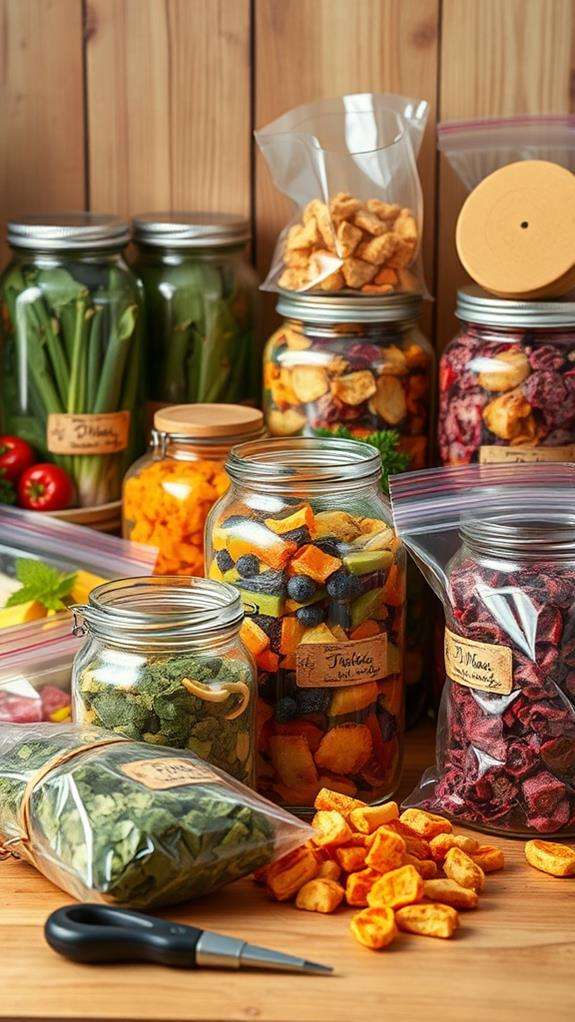
You'll need to make smart choices about storage containers for your dehydrated foods, including glass jars with tight-fitting lids, food-grade plastic containers, or specialized storage vessels designed for long-term food preservation. When it comes to sealing methods, vacuum sealing stands out as your best option since it removes air that could lead to spoilage and extends shelf life considerably longer than conventional storage methods. While both Mylar bags and plastic bags can work for storing dehydrated foods, Mylar offers superior protection against light, moisture, and oxygen, making it the preferred choice for serious food preservation efforts.
Proper Storage Container Types
Selecting the right storage containers makes a critical difference in how long your dehydrated foods will stay fresh and safe to eat. You'll want to choose containers that provide an airtight seal and protection from light, moisture, and temperature fluctuations. Glass jars, food-grade plastic containers, and mylar bags are among the most effective options for long-term storage.
When choosing your storage containers, consider these essential factors:
- Material composition – Glass containers offer excellent moisture resistance and won't leach chemicals, while food-grade plastic containers are lightweight and less prone to breakage. Mylar bags provide superior oxygen and light protection.
- Seal integrity – Look for containers with reliable gaskets, twist-on lids, or heat-sealed closures that maintain an airtight environment. Double-check that your containers don't have any cracks or damage that could compromise their seal.
- Size appropriateness – Choose containers that match your portion needs to minimize repeated opening and closing. Smaller containers help maintain freshness for items you'll access frequently, while larger ones work well for bulk storage.
For best results, you'll want to combine these proper containers with oxygen absorbers and vacuum sealing when applicable.
Vacuum Sealing Best Practices
Vacuum sealing creates an ideal environment for preserving dehydrated foods by removing air that could lead to spoilage or oxidation. When you're ready to seal your dehydrated foods, you'll want to choose high-quality, food-grade vacuum bags that are at least 3-4 mil thick to prevent punctures and maintain a proper seal.
Before sealing, make certain your dehydrated foods have cooled completely to room temperature to prevent condensation inside the bags. You'll need to work in small batches, placing reasonable portions in each bag while leaving about 3 inches of headspace for proper sealing. If you're packaging items with sharp edges, like dried fruit pieces or vegetables, consider using bag protectors or double-bagging to prevent punctures.
When operating your vacuum sealer, make sure the bag's open end is clean and dry, as moisture or food particles can compromise the seal. Position the bag's edge squarely across the sealing strip, and apply firm, even pressure during the sealing process. For powdery items like dried herbs or ground vegetables, place a coffee filter or paper towel at the top of the bag to prevent particles from interfering with the seal.
Mylar Vs Plastic Bags
Two main packaging options dominate the dehydrated food storage scene: Mylar bags and plastic bags. While both serve the purpose of storing dehydrated foods, they offer different levels of protection and longevity for your preserved items. Mylar bags, made from multiple layers of metal-like polyester film, provide superior protection against light, moisture, and oxygen compared to their plastic counterparts.
When choosing between these storage options, consider these key differences:
- Barrier Protection: Mylar bags offer a nearly impenetrable barrier against environmental factors, maintaining an oxygen transmission rate below 0.0003cc/m²/day, while plastic bags typically allow 3-4cc/m²/day
- Cost Efficiency: Plastic bags are more affordable for short-term storage, costing about 75% less than Mylar, but you'll need to replace them more frequently
- Durability: Mylar bags can withstand temperatures from -60°F to 180°F without degrading, while plastic bags begin breaking down at around 120°F
For long-term food storage exceeding one year, you'll want to invest in Mylar bags. They're particularly effective when combined with oxygen absorbers, creating an environment that can preserve your dehydrated foods for up to 25 years when properly sealed and stored.
Signs of Spoilage
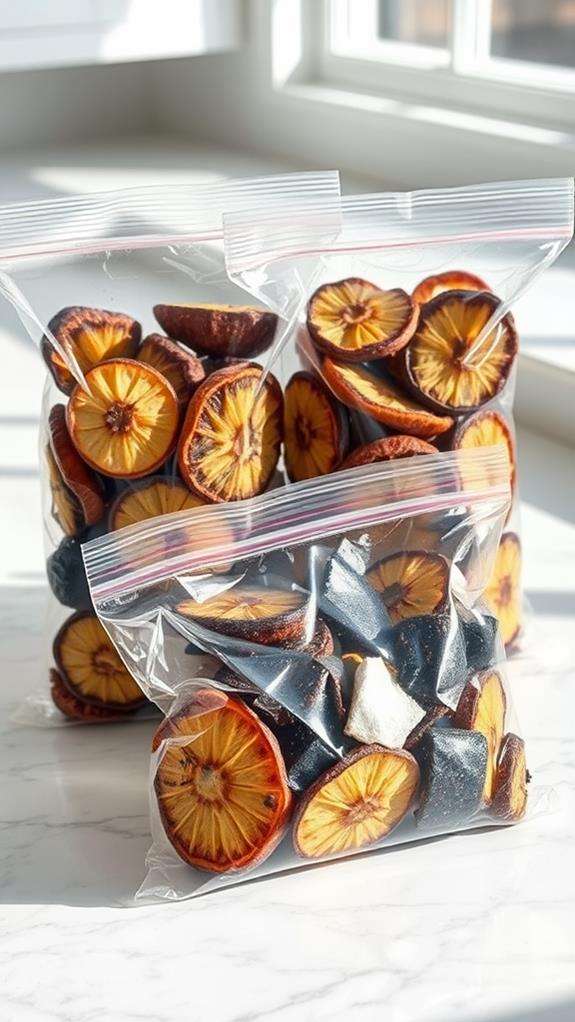
Spotting spoiled dehydrated food requires careful attention to specific warning signs. You'll need to use your senses to identify potential issues before consuming stored items. When examining your dehydrated foods, check for changes in color, texture, and smell that might indicate deterioration.
| Warning Sign | What to Look For | Action Required |
|---|---|---|
| Visual Changes | Discoloration, mold spots, crystallization | Discard immediately |
| Smell Issues | Rancid, sour, or unusual odors | Don't consume, throw away |
| Texture Problems | Moisture, clumping, excessive hardness | Check packaging, dispose if uncertain |
You'll want to inspect your stored items regularly, particularly in areas where temperature and humidity fluctuate. If you notice any containers that have lost their vacuum seal, you should investigate the contents right away. When moisture finds its way into your dehydrated foods, it creates an environment where bacteria and mold can thrive. Don't take chances with items showing multiple warning signs – it's better to dispose of questionable foods than risk foodborne illness. Remember that proper storage conditions markedly impact how quickly these warning signs might develop.
Expected Shelf Life Chart
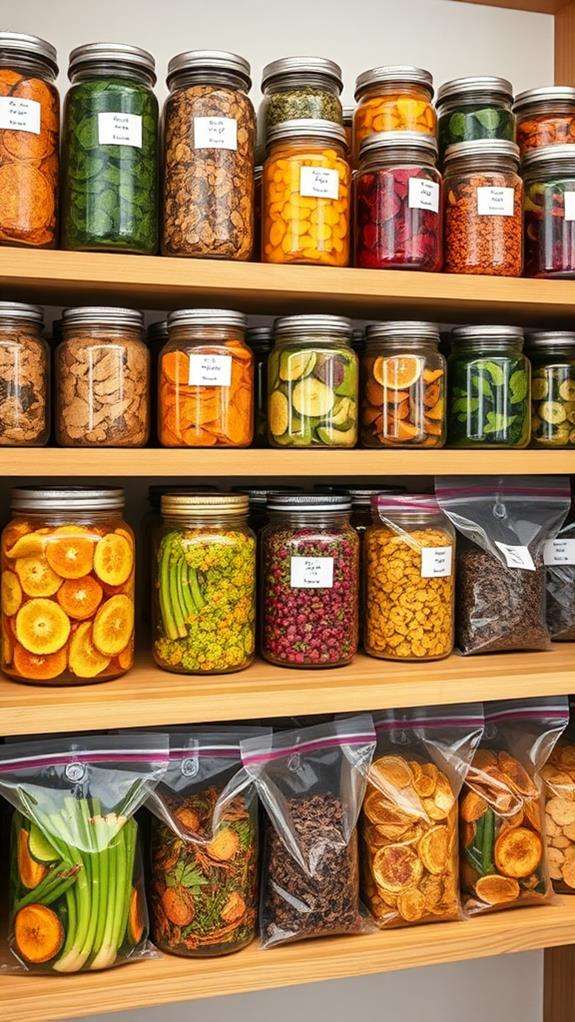
Different dehydrated foods maintain their quality for varying periods, making it essential to understand their expected storage durations. When properly vacuum sealed and stored in ideal conditions (cool, dark, and dry), you'll find that most dehydrated foods can last considerably longer than their non-dehydrated counterparts.
- Fruits and vegetables typically maintain their quality for 10-15 years when properly dehydrated and vacuum sealed, with items like apples, carrots, and corn showing exceptional longevity due to their lower natural oil content.
- Meats and proteins, including beef jerky and dehydrated chicken, can last 5-10 years when properly prepared and stored, though their shelf life varies based on their fat content and processing methods.
- Herbs and spices retain their potency for 2-5 years in vacuum-sealed containers, with leafy herbs generally having shorter shelf lives than whole spices.
You'll want to regularly check your storage conditions, as temperature fluctuations and humidity can considerably impact these timeframes. Remember that while these are general guidelines, factors like pre-treatment methods, moisture content at packaging, and storage environment will affect the actual shelf life of your dehydrated foods.
Moisture Content Guidelines
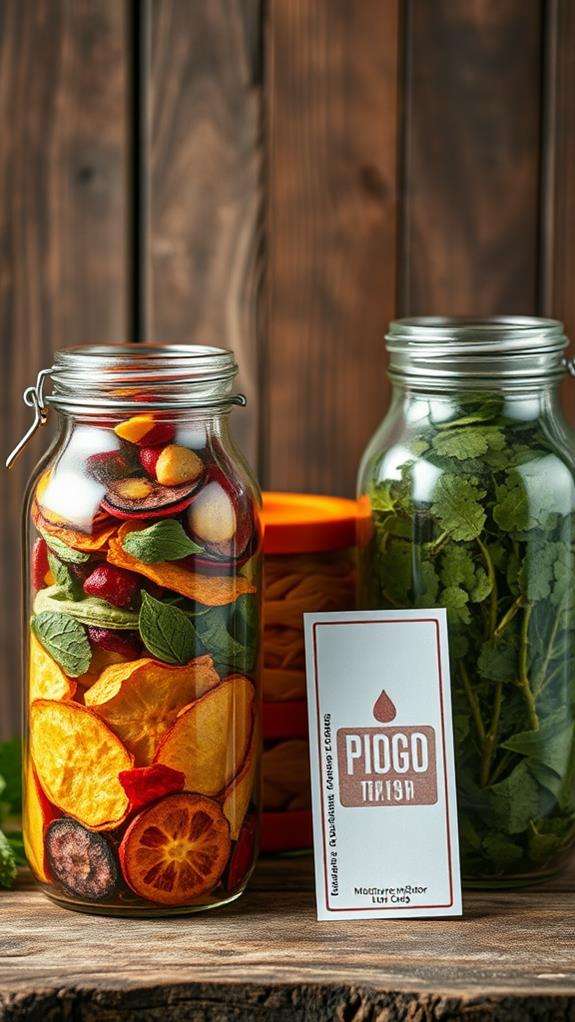
Achieving the proper moisture content in dehydrated foods is essential for long-term storage success. You'll need to ascertain your food items reach specific moisture levels to prevent spoilage and maintain quality. For fruits, you'll want to aim for 20% moisture content or less, while vegetables should contain no more than 10% moisture. Meats require even stricter control, with a target of 5% or lower moisture content.
You can test your food's readiness using several methods. The most reliable approach is using a moisture meter, which provides precise readings. If you don't have one, you'll need to rely on physical indicators. Properly dried fruits should be pliable but not sticky, while vegetables should be brittle or crisp. For meats, you're looking for a jerky-like texture that breaks cleanly when bent. If you notice any moisture beading up when you squeeze the food, it needs more drying time.
Remember to check multiple pieces from your batch, as thickness variations can lead to uneven drying. You'll want to store only thoroughly dried items to prevent moisture pockets that could lead to mold growth.
Temperature and Light Considerations
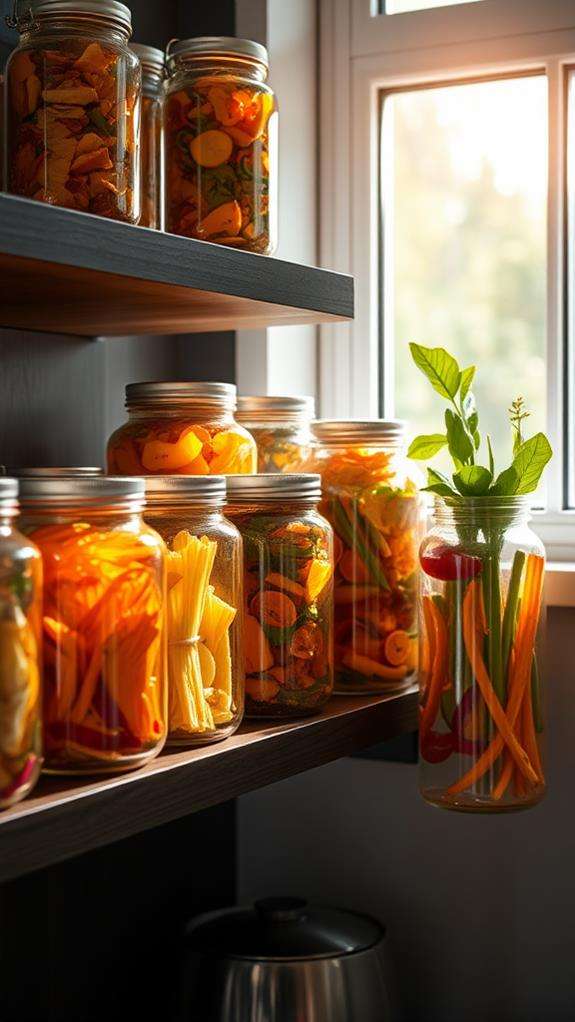
Storing dehydrated foods away from heat and light will greatly extend their shelf life. You'll want to maintain a consistent storage temperature between 50-70°F (10-21°C), as temperature fluctuations can lead to condensation and potentially compromise your food's quality. Light exposure, especially UV rays, can break down nutrients and cause oxidation, which affects both flavor and nutritional value.
To maximize your dehydrated food's longevity, follow these essential temperature and light management practices:
- Store your containers in a cool, dark basement or pantry, avoiding areas near heating vents, sunny windows, or appliances that generate heat.
- Use opaque containers or vacuum-sealed bags with oxygen absorbers, as they'll provide an additional barrier against light exposure and moisture.
- Monitor your storage area's temperature with a thermometer, and if you notice seasonal fluctuations, consider relocating your dehydrated goods to a more stable environment.
If you're storing food in a garage or outbuilding, you'll need to be particularly vigilant about temperature control, as these spaces often experience extreme variations that can considerably reduce your food's shelf life.
Frequently Asked Questions
Can Vacuum-Sealed Dehydrated Foods Be Reused After Opening the Package?
You're in a pickle when it comes to reusing opened vacuum-sealed dehydrated foods, but don't worry. You can reuse them if you store the remaining portion properly. Transfer unused portions to an airtight container or resealable bag, removing as much air as possible. You'll need to use these opened items within 1-2 weeks, even with proper storage. Keep them in a cool, dry place away from direct sunlight to maintain quality.
Does Vacuum Sealing Eliminate the Need for Oxygen Absorbers Completely?
While vacuum sealing considerably reduces oxygen exposure, it doesn't completely eliminate the need for oxygen absorbers. You'll still want to use oxygen absorbers because vacuum sealing can't remove 100% of the air, and even tiny amounts of remaining oxygen can affect food quality over time. For best results, you should use both methods together – vacuum seal your dehydrated foods and include oxygen absorbers for maximum protection against oxidation.
How Do Different Altitudes Affect the Storage Life of Dehydrated Foods?
You'll find that altitude greatly impacts your dehydrated food's storage life. At higher elevations, where air pressure is lower, you'll need to extend your drying time by 25-50% to achieve proper dehydration. The lower atmospheric pressure also means there's less oxygen, which can actually help preserve your food longer. However, you'll want to adjust your storage containers' seals, as they might not work as effectively at high altitudes.
Will Vacuum-Sealed Dehydrated Foods Maintain Their Original Color Over Time?
You'll notice that vacuum-sealed dehydrated foods will gradually lose their original color over time, even with proper storage. This color change happens due to oxidation and exposure to light, though vacuum sealing greatly slows this process. While your fruits might darken and vegetables may fade, these color changes don't necessarily mean the food has spoiled. To best preserve color, you'll want to store your vacuum-sealed items in a dark place.
Can Pets Safely Consume Expired Vacuum-Sealed Dehydrated Food Products?
Did you know that 85% of pet owners have considered giving their pets expired food at some point? You shouldn't feed your pets expired vacuum-sealed dehydrated food, even if it appears intact. While vacuum sealing extends shelf life, expired products can harbor harmful bacteria and lose essential nutrients. If you're uncertain about your pet's food, you'll want to check with your vet and always prioritize fresh, properly stored products within their expiration dates.





